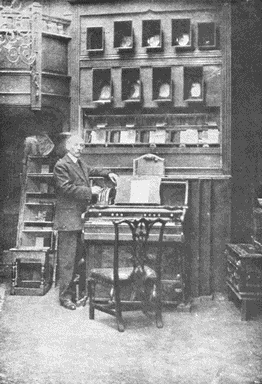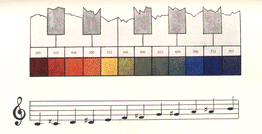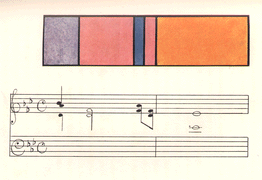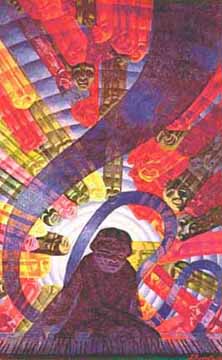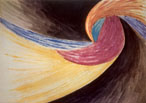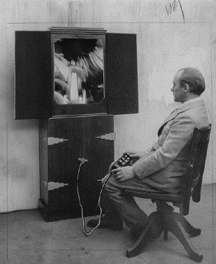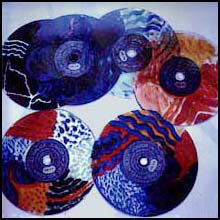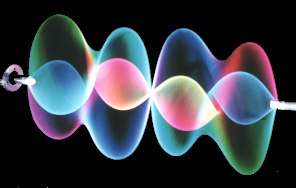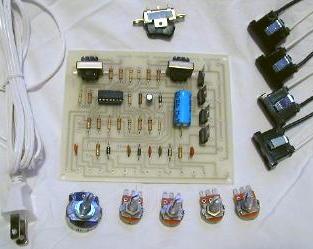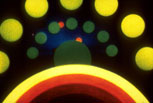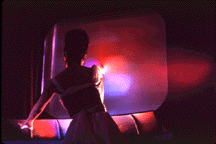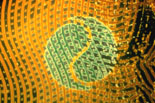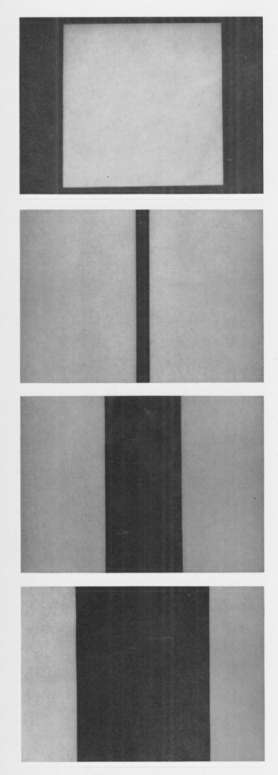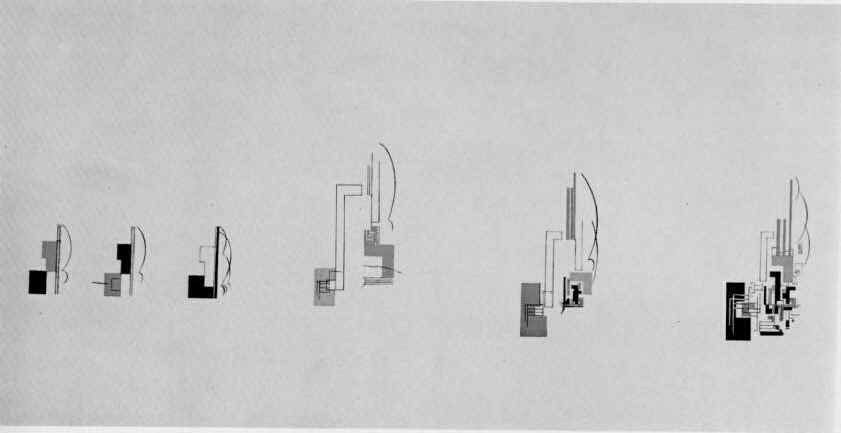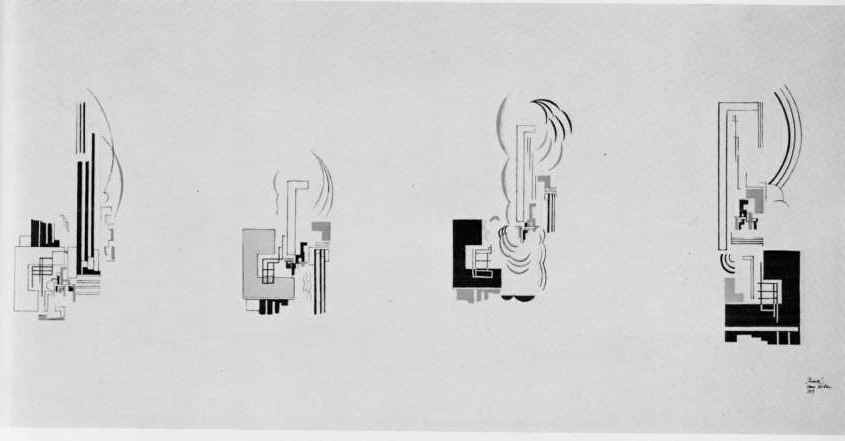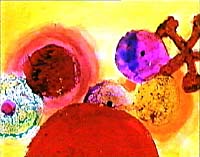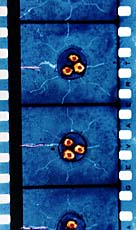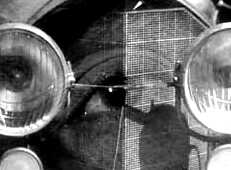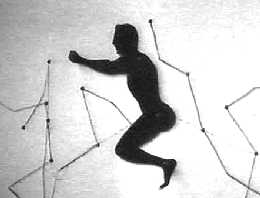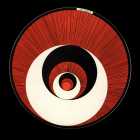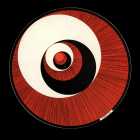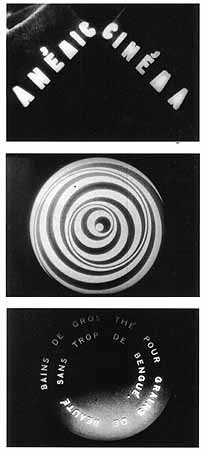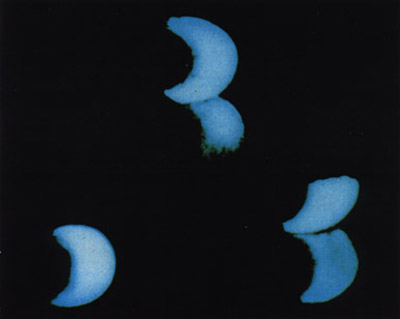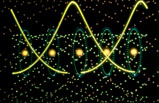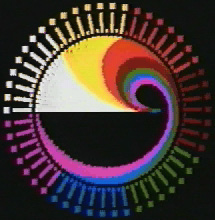Visual Music
by Maura McDonnell (2002) - email: mmcd@soundingvisual.com
Acknowledgements
Recent Writings on Visual Music by Maura McDonnell
Early Colour organs "The early history of this art was driven by an interest in
color. In the eighteenth century, a Jesuit priest, Louis-
Bertrand Castel, invented the first color organ. Others,
including D.D. Jameson, Bainbridge Bishop, and A.
Wallace Rimington, created color organs through the next
century [2].
...By 1930, Thomas Wilfred had coined the word lumia to describe the emerging art, and organized the structure of lumia around three factors. "Form, color and motion are the three basic factors in lumia-as in all visual experience-and form and motion are the two most important" [4]. It was with Wilfred's Clavilux that controls came to be organized into three groups.
INTERESTING LINKS The Dream of Color Music, And Machines That Made it Possible
by William Moritz Research Paper: Synesthesia & Design : A symbiosis by
Stewart Ziff Soundings Suzanne Delehanty From SOUNDINGS, Neuberger
Museum, SUNY Purchase, 1981 A history of Light and Lighting Light Shows |
|||||||||||||||
| Influenced Stage Lighting, Abstract Filmmakers, Music and Image |
|||||||||||||||
EXAMPLE PAINTER - Australian artist ROY
DE MAISTRE Painting Color Music
|
|||||||||||||||
Paul Friedlander
web site: http://www.paulfriedlander.com/
Defines three types of Visual Music at his website: http://www.paulfriedlander.com/text/visualmusic.html
Download ZIP ART for free from his site - It is his first experiment
at creating a visual instrument with a computer. |
|||||||||||||||
HSV- COLOR MODEL Fred Callopy of rhythmiclight recommends using the HSV colour model when attempting to map colour to music. Fred Callopy of rhythmiclight recommends using the HSV colour
model when attempting to map colour to music. In his website
he gives an excellent account of colour and music in terms of
history and in terms of designing software that maps colour to
music. His imager software is utilised by himself to create
colours and forms that respond to music.
HUE SATURATION VALUE |
|||||||||||||||
ONE EXAMPLE #9935 - Color Organ ‘Power Blaster’ Musical Light
Show Kit $25.90
Psychedelic light show special effects |
|||||||||||||||
Contemporary Colour and Sound Work Realtime area The Audiovisual Environment Suite (AVES) is a set of five interactive
systems which allow people to create and perform abstract animation
and synthetic sound in real time.
Download various web video clips at: http://acg.media.mit.edu/people/golan/aves/ REALTIME LINKS |
|||||||||||||||
VISUAL MUSIC EARLY MUSIC LED FILMMAKERS/ANIMATORS/ARTISTS Parallel in the 1920s to people working with color organs, Walther Ruttmann and Oskar Fischinger were pioneering visual music films in Germany, using tinted animation to live musical accompaniment. Many of Music Led Films are highly abstract pieces analagous to abstract painting. However others aren't, and make use of the medium and techniques of film and cinema to create film material. The advent and development of computer animation and computer manipulation has made many of the techniques explored by earlier avant-garde experimental filmmakers very accessible and effortless to use. (like music concrete to soundforge) |
|||||||||||||||
Ideas Explored Anaologies between music and visual art - to film Music Analogies such as Orchestration of Visual elements in
terms of Time, Contrast, Similarity (Hans Richter in Rhythms
films)
|
|||||||||||||||
Oskar Fischinger
|
Visual Music
Categories
|
||||||||||||||
| Oskar Fischinger | See Oskar Fishinger's writings online at www.oskarfischinger.org - see Articles section COLOR ORGAN "Fischinger´s attitude towards music could be held as somewhat ambiguous but according to Moritz he did not regard his films as musical visualizations. He held the abstract imagery to contain qualities parallel to the ones found in music, and the actual soundtrack used as means to attract the attention of the audience to recognize this (Moritz 1974:50). The audience, then as now, were more inclined to accept music as "abstract" artform than they were towards painting, where the question; "what does this represent?" is bound to appear. Fischinger saw himself as an abstract expressionist but in contrast to fellow artists such as Jackson Pollock, he constantly searched for visual harmony in his art." http://www.animertedager.no/anasmus.html [Broken Link]
Influenced Resources on Oskar Fishinger - Center for Visual Music At the Center for Visual Music, there are articles, see Library http://www.centerforvisualmusic.org/Library.html and a Gallery with a a number of Fischinger animation drawings). http://www.centerforvisualmusic.org/Gallery.htm
|
Images Above Circular images above are painted slides by Matthias Holl used by László in his 1920s Farblichtmusik performances (thanks to C. Keefer at the The Center for Visual Music for this information) Lumigraph "In the late 1940s, he also invented a color organ instrument that allowed one to play lights to any music very simply. His Lumigraph hides the lighting elements in a large frame, from which only a thin slit emits light. In a darkened room (with a black background) you can not see anything except when something moves into the thin "sheet" of light, so, by moving a finger-tip around in a circle in this light field, you can trace a colored circle (colored filters can be selected and changed by the performer). Any object can be used: a gloved hand, a drum-stick, a pot-lid (for a solid circle), a child's block (for a square), etc. Oskar performed certain compositions (such as Sibelius' "Valse Triste") publicly, at the Coronet Theater in Los Angeles, and at the San Francisco Museum of Art in 1953, in connection with a one-man show of his abstract oil paintings
Oskar's original Lumigraph does survive, in the Deutsches Filmmuseum in Frankfurt, where it is played with some regularity, and it has been loaned to the Louvre in Paris and the Gemeente Museum in the Hague for performances by Oskar's widow Elfriede. Oskar's son Conrad also constructed two other Lumigraphs, one large one that was used on an Andy Williams television special, and a smaller one to use in Los Angeles performances. The Lumigraph also appeared in a 1964 science-fiction movie The Time Travelers, in which it is a "love machine" that allows people to vent their sexual urges in a harmless sensuality. LINK |
Oskar Fishinger DVD The first Fischinger DVD will be released May 2006, go to
You can buy Oskar Fishinger's films in vhs and soon to be released
DVD format at the Center for Visual Music |
||
You can buy Oskar Fishinger's films in vhs and soon to be released
DVD format at the Center for Visual Music |
||
Len lye
|
Direct Films "There has never been a great film unless it was created in the spirit of the experimental filmmaker."
|
"All of a sudden it hit me - If there was such a thing as composing music, there could be such a thing as composing motion. After all, there are melodic figures, why can't there be figures of motion?" |
|
||
Hans Richter
|
Hand painted films
"We realized that the “orchestration” of time was the esthetic basis of this new art form." Richter's position in the art world was unique. As one of the
earliest exponents of Dada, he was also one of the first to recognize
the new possibilities cinematography offered the artist. He
participated in the first avant-garde film movement alongside Léger,
Duchamp, Man Ray, Picabia, Cocteau and Dali, and later in New York
his teachings would influence many of the "New American Cinema" filmmakers. Films such as Rhythmus 21 (Rhythm 21) 1921
Shown in camera and rhythm class. web clip available at revoir website
FILMS available ar re-voir website: |
Scroll Paintings eg Preludium (Prelude) 1919 Richter and Swedish painter Viking Eggeling experimented with several artistic techniques and different media for expression. such as the Chinese language. "They did not study the language to learn Chinese, but to understand the relationships between the lines and curves of the symbols. Eggeling's focus was more on the lines themselves, whereas Richter was concerned with the interplay between the lines. This is when Richter begins to bring together his ideas positive-negative relationships and reshape them into rhythmic expression. "...a vertical line was accentuated by a horizontal, a strong line connected with a weak one, a single line gained importance from many lines etc."
…this kind of film gives memory nothing to hang on. At the mercy of "feeling", reduced to going with the rhythm according to the successive rise and fall of the breath and the heartbeat, we are given a sense of what feeling and perceiving really is: a process - MOVEMENT." -Hans Richter 1924 SEE: |
Contemporary handpainted films Two Additions to the Tradition Two younger filmmakers have also devoted themselves to making abstract films directly on the filmstrip: Richard Reeves in Canada and Bärbel Neubauer in Austria and Germany. Bärbel Neubauer Roots: An Experiment in Images and Music by Bärbel Neubauer. Roots is a metamorphoses of color and form which is painted, drawn and stamped directly on blank film and corresponds to rhythm and music. Download quicktime at http://www.awn.com/mag/issue3.6/3.6pages/3.6neubauerroots.html
Moonlight Richard Reeves'
Linear Dreams Linear Dreams, at seven minutes, has an epic sweep. It begins with a pulsating sound like a heartbeat and images of a throbbing red circle with nervous, scratched lines touching it from the sides,.... http://www.awn.com/mag/issue3.6/3.6pages/3.6moritzfilms.html Putting these films in a context, bleep from site: Len Lye and Norman McLaren made such an impression with their abstract films painted and scratched directly onto film that when some other cameraless film begins to screen at a festival one often hears several disgruntled voices saying, "McLaren and Lye already did this"--as if nothing new could be done with the technique. Drawing or scratching directly onto film strips is just a technical means, and nobody would think of saying, "Painting on cels? That's already been done, so I won't watch this new film..." Several people like, the Italian brothers Arnaldo Ginna and Bruno Corra, the German Hans Stoltenberg and the Belgian Henri Storck, painted abstractions on film before Lye and McLaren, but these films do not survive for us to see or judge. Films like Lye's Colour Box and Free Radicals or McLaren and Evelyn Lambart's Begone Dull Care are superb masterpieces that one can see over and over, and remember fondly. Plus, the tradition of direct abstract film continues: the great Basque painter Jose Antonio Sistiaga made a feature-length direct abstract film, Ere Erera Baleibu Icik Subua Aruaren, released in 1970, while Lye and McLaren were still alive. Believe it or not, all 75 minutes of it are fascinating, with a cumulative satisfaction. Sistiaga's 1989 7-minute Impressions In The High Atmosphere is a breathtaking masterpiece. A central circle, stable except for its fluctuating enamel-like textures, is surrounded by restless, swirling currents. His 1991 14-minute Nocturne is again a deeply moving, and very beautiful, film. |
||
Abstract Filmmakers - Music Led "Shortly after the end of the nineteenth century, a strong avante
garde movement was moving throughout the world of art. Expressionism,
constructivism, surrealism, cubism, and dadaism were all parts
of this newly structured abstract art. Traditional theories of
representational art were thrown out the window. New ways of working
with space, shape, form and even time began to make their way into
the artistic scene. Near the forefront of this movement was a painter
by the name of Hans Richter." Twentieth-century painters and photographers in Germany and France,
confronted with the increasing dynamism of everyday life, investigated
the technical and aesthetic fundamentals of film. They hoped with
this new medium to achieve 'a dance-like motion of the entire image'
(W. Ruttmann). With new single frame exposure and montage techniques
of single frames, the filmmakers of 'absolute' and surrealistic
film succeeded in setting in motion even static images and stationary
objects. Because of the numerous European experimental filmmakers
who fled National Socialism, the avant-garde cinema of the Twenties
reached the U.S.A during World War II. Young filmmakers eagerly
adopted the avant-garde and further developed it in their own sound
and colour films. Still today, artists with varying aspirations
are interested in dancing images because it enables them to compose
visual music, exhaust the borders of perception or extend dance
to new dimensions. Visual Music |
||
Man Ray "Inventions of light forms and movements" is the way Man Ray described the films he made in the 1920s. |
Surrealist Filmmaker Visual Poetry "Of the small handful of films which the great surrealist artist Man Ray made in the 1920s, Emak-Bakia is arguably the one which adheres most closely to the principles of Dadaist surrealism. It is also perhaps the most baffling of Man Ray’s films, involving some of his most extraordinary abstract visual imagery, with far less recognisable images than his other films, such as L’Étoile de mer and Les Mystères du château de Dé. The film is in fact closer in style to Man Ray’s 1923 experimental short film, Le Retour à la raison, and uses some of the techniques which the artist invented for that film. The title “Emak-Bakia” was taken from an old Basque expression, which translates as "Don't bother me." Link True to Dadaist tradition, Man Ray questioned the application
of prevailing logic in the sequence of images in his films. The
represented should only stand for itself. Images should not be
bound together by means of a general content, but only through
montage. In this way, in "Emak Bakia”, light and its reflections
along with the movement of bodies and objects become pure visual
poetry. |
Emak-Bakia 1926 Art / Fantasy
|
|
||
Marcel Duchamp
|
Rotorelief Discs
LINK LINK |
Anaemic Cinema 1926
|
Resources on Duchamp at: |
||
| Walter Ruttmann |
Absolute film to representational imagery The creator of the early abstract films Opus I, II, III and IV, began this, probably his best know film, in 1926. Ruttmann directed the film and collaborated with Carl Mayer (a screen writer who had co-written the script for Das Cabinet des Dr. Caligari), Karl Freund (the director of Fox-Europe Production), and Lore Leudesdorff who had already assisted Ruttmann with Opus III andIV. Rather than write a conventional script Ruttmann devised a card system that allowed for flexibility and reshuffling of ideas for scenes and the overall structure of the film. In addition to written notes for an idea, a card included specifications about the length of the scene, the desired atmosphere, and a visual sketch, a mini-storyboard so to speak. The music that accompanies the film was written by Edmund Meisel who also directed the orchestra at the film’s public opening at the Tauentzien-Palast in Berlin. Ruttmann and Meisel worked closely together aiming at a harmonious whole consisting of images and music, and Meisel described the music as a “conglomerate of the various sounds of a metropolis”. Since creating his purely abstract Opus films Ruttmann had made a number of advertisement films for Julius Pinschewer, had worked on Paul Wegener’s film Lebende Buddhas, had created the dream sequence for Fritz Lang’s Die Nibelungen, and had made the beginning sequence, some of the background imagery, and other scenes for Lotte Reininger’s silhouette film Die Abenteuer des Prinzen Achmed. His advertisement films combined abstract with representational imagery and color with black and white sequences, and his contributions to the feature films meant, of course, that his largely abstract images were subsumed within a larger, representational whole. These were precisely the two uses of purely abstract filmic images that the critics of the absolute film approved of. By the time he began Berlin, Symphony of a Great City, Ruttmann had come to the conclusion that he needed representational imagery to accomplish his vision in film. Clips of Berlin, Symphony of a Great City (1927) available at: Link
|
Films Opus 1,11,111,1V Still from opus 1
Walter Ruttmann first produced his painted films Opus
II and III entirely based on the momentum of flowing abstract forms
which he painted on a glass plate. He placed this plate under the
camera on an animation stand, so that he could expose individual
frames at the appropriate moment. The impression of movement in
the final film is created by the frequency of exposures he made
of these flowing changing forms. http://www.sk-kultur.de/ Berlin, Symphony of a Great City (1927) |
| John and James Whitney |
The use of the computer in experimental film making has a rich history which reached a peak in the late 1960s, but stemmed from the early approaches and experimental 16mm work by key figures John and James Whitney in the late 1940s. The Whitney brothers were exploring 16mm experimental film, gaining a reputation for their Film Exercises made between 1941-44. The Whitney's had a formidable background in traditional film making techniques winning first prize at the first Experimental Film Festival in Belgium in 1949. John Whitney (1917-1995) later became director of animated films at UPA producing, in association with Saul Bass, the stylized and hypnotic opening title sequence for Hitchcock's Vertigo. By the early 1960s, with his own company Motion Graphics Inc., he was exploring his passion for the realisation of experimental films using hand built technologies. John designed and built an "analogue computer" - a machine to realise effects and ideas that had up to that point no technical means of expression. At the time they said they were "trying to make something and there wasn't a machine available for making it". It allowed infinitely complex rotational camera movement, filters and multiple variations for shutter operations, including slit-scanning; the technique Douglas Trumbull later developed and refined for Stanley Kubrick's experimental sequences in 2001, but which had actually been used by the Whitney family a number of years earlier. Apart from collaborations with his brother, James Whitney (1921-1982) made two key films during this period - Yantra (1950-55) and Lapis (1963-66) which explore the mandalic possibilities of film. The first Yantra, was made painstakingly by hand using animation techniques and the second Lapis utilised the advantages offered by the analogue computer being able to generate more complex imagery much faster. http://www.filmwaves.co.uk/3digital.htm [Broken Link] Digital Harmony John Whitney's classic book, "Digital Harmony" (1980), described/illustrated what went into the creation of "Arabesque." "Digital Harmony" also set forth John Whitney's theories on fusing music and imagery. For him music was visual, imagery musical, and digital computers offered the possibility of algorithmically melding the two. With the "Moondrum" (1991) series of computer graphics films he composed a musical soundtrack on a midi keyboard simultaneous to generating abstract imagery. http://www.wigged.net/html/news/whitney.html [Broken Link] The 80's would see an expansion of Whitney's exploration of digital harmony. By now he was composing his own music, searching for, as he writes, "a special relationship between musical and visual design." (Whitney, 1991). Whitney was defining a new kind of composer: One with the ability to conceive ideas both musically and visually. "Whether quick or slow, action, as well as harmony, determines much of the shape of my own audio-visual work today. Action itself has an impact on emotions. Fluid, orderly action generates or resolves tensions much in the manner that orderly sequences of resonant tonal harmony have an impact on emotion and feeling..." (Whitney, 1991). The late 1980's would see numerous John Whitney works, combinations of original music and visuals. From Spirals in 1988, to Moondrum, a Native-American influenced series of works completed in the span of 1989-1995, Whitney was now using a special composing program developed in association with programmer Jerry Reed called the RDTD, that enabled the artist to create "musical design intertwined with color design tone-for-tone, played against action-for-action" (Whitney, 1996). LINK
Music is the supreme example of movement become pattern. Music is time given sublime shape. If for no other reason than its universality and its status in the collective mind, music invites imitation. A visual art should give the same superior shape to the temporal order that we expect of music. "The compositions at best are intended to point a way toward future developments in the arts. Above all, I want to demonstrate that electronic music and electronic color-in-action combine to make an inseparable whole that is much greater than its parts." John Whitney, Sr. died September 22, 1995 in Los Angeles, California, ending a remarkable career that linked music to experimental film and later to computer imaging. John Hales Whitney was born April 8, 1917 in Pasadena, California; he attended Pomona College, Claremont University before spending a year in Paris from 1937 to 1938. While in Paris, he studied Schoenberg's Twelve Tone techniques with Rene Liebowitz and worked on the animation of abstract designs. KEYWORDS Motion Pattern Time |
MOTION Music with Imagery Book: Digital Harmony (1980) Click image for link to quicktime clip |
Links http://www.siggraph.org/artdesign/profile/whitney/motion.html |
||
| Norman McLaren | McLaren was born in Scotland in 1914 and while studying art
he had become increasingly interested in the potential of filmmaking. McLaren began painting directly on stock in the 30s and in 1949 he made the wonderful Begone Dull Care to jazz music by Oscar Peterson's trio. According to Giannalberto Bendazzi the film won excited acclaim from Picasso who praised it in the following way; "Finally, something new!" (Bendazzi 1994:116) McLaren´s films shows a multitude of different styles and techniques from minimalistic abstract work to short narrative films like the pixillated Oscar winner Neighbours (1952) and the beautiful interpretation of dance in Pas de Deux (1959). McLaren´s investigations of the cinema includes the production of synthetic sound as in the mentioned Neighbours and Two Bagatelles (1952). Cinematic experiments creating sound without using external
sources began in the 20s with the recognition that patterns read
optically can produce sound. This very direct notion of "seeing" sound
attracted Fischinger in the early 30s as it later did McLaren. http://www.animertedager.no/anasmus.html Influenced |
|
| Lejf Marcussen | The investigation of visual realities is crucial for the Danish filmmaker Lejf Marcussen (b. 1936). In the early 70s he joined the Danish broadcasting company Danmarks Radio where he began making experimental films. While his films reveals a mixture of different techniques the notion of film as non-verbal artform is strong in all of them. In Tonespor (1983) he makes a visual interpretation based on music by Carl Nielsen. Each instrumental group or musical "voice" is represented by a coloured line which closely follow the musical movement. |
|
| Stan Brackhage |
There is a form of film that is trying to evolve that area of thinking which I call 'moving visual thinking'. And it is intrinsically a visual music.... |
 |
| Harry Smith |
My films are more or less educational - I've never done much with them as far as illucidating what the subject matter is - but they are like the basic rhythms that are in music. |
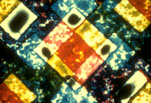 |
| Mary Ellen Bute | Background in Painting. She wanted to "wield light in a flowing
time-continuum". Studied stage and lighting in order to build a color
organ. Her visuals were made to music and that music was seen in
terms of their mathematical formulae. She was influenced by musician
Joseph Schillinger. He had developed a theory about musical structure,
which reduced all music to a series of mathematical formulae. They
had collaborated on a film together that was never made.. However
his mathematical approach to music influenced all her animation films. |
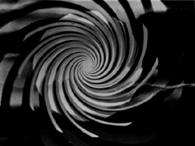 |
| A. Wallace Rimington | We have, therefore, in colour, as in music, both discord and harmony, wide in their scope and mutually dependent. We can in both produce series and sequences of harmonies differing in their degree of pleasantness. We can change them into discords and resolve them again into harmonies, we can, in fact, use colour as we use musical sounds. | |
| L. Delluke | photogenius | |
| W. Lindsay | Music of Movement | |
| P. Vegener | Visual Symphony | |
| Sergei Eisenstein | Music of Light | |
| J.Dullac | Integral Cinematograph | |
| Visual Music Light-Music |
Definition of some experimental cinema as being "visual music".
Where there is a dynamic action and expressiveness of cinema images,
an important role of rhythm, plasticity and light. This visual music
reflects its closeness to music and dance. Often abstract and plotless visualisation of music. Many films appear to be a visual potrait of music being enriched with music intonation, content and meaning |
|
| D. Vertov | Cinema Eye | |
| N. Voinov | 1931 Abstract film to Rachmaninov's "Prelude in Csharp minor" | |
| V. Eggeling | (Sweeden) Diagonal Symphony (1917) |
|
| P. Dukas | ||
| N. McLaren | His films were closer to painting and light-music and he developed
a manual technique of scratching coloured images by hand onto the
surface of the film strip. Some Resources |
|
| Scriabin | Prometheus http://users.unimi.it/~gpiana/dm4/dm4scrlt.htm |
|
| Sviridov | Small triptych (1975) | |
| B.Galeyev | Eternal Motion (1969), Space Sonata (1981). Reverse method of visuals then music used | |
| Norman McLaren | Dream of Colour Music | |
| Articles | ||
The Dream of Color Music, And
Machines That Made it Possible by William Moritz Mary Hallock Greenewalt with her Visual-Music Phonograph (1919.) Photo by Shewell Ellis. |
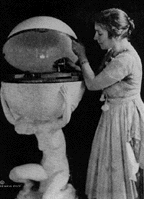 |
|
Animation as music by Rune Kreutz COLLAPSING IMAGE INTO MUSIC: Part 1 Musique Concrete, electronica & Sound
Art published: The Wire No.166, 1997, London |
||
Links
Music and Image Tools Links
Extensive resource listed at the rhythmic light site, including its
own imager software. - Link
Synesthesia
http://home.comcast.net/~sean.day/Synesthesia.htm
http://www.cinedoc.org/index_en.asp
Art Science
http://www.artscienceresearchlab.org/
Prix ars electronica archive
http://prixars.aec.at/history/index_e.html [Broken Link]
This site was compiled in 2002 by Maura McDonnell in order to gather together some resources and links on the history of colour and sound and visual music. If you wish to make any suggestions or comments, please do contact me. Email: I will be updating the design of this page in the near future. The site consists mainly of quotes from articles, and historical documents that were available online in 2002. The path through the topic is the authors own path. Thanks to C. Keefer at the Center for Visual Music for checking over the page. The Center for Visual Music has extensive resources in relation to this topic. Thanks also to Fred Callopy of Rhythmic Light for his extensive online resources, in particular historical documents that he has made available online.
Maura McDonnell (2002)
See also more recent notes M. McDonnell has compiled at: http://www.soundingvisual.com/visualmusic/
Maura also creates visual music work, this can be seen on her website: http://www.soundingvisual.com
Updated April 2006
RECENT WRITING on Visual Music by Maura McDonnell
Visual
Music Essay (2007)
(originally published in the
programme catalogue for the Visual
Music Marathon Event held in Boston USA, 2007 organised by Dennis
H. Miller - the online version is not illustrated, however, the catalogue
version is richly illustrated with images )
Visual Music
Blog (started 2005)

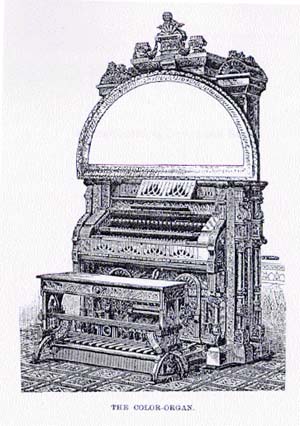 In 1893, Bainbridge
Bishop published regarding his scheme of correspondences
for colored notes, which he deemed as being correct
according to nature as displayed by rainbows:
In 1893, Bainbridge
Bishop published regarding his scheme of correspondences
for colored notes, which he deemed as being correct
according to nature as displayed by rainbows: 